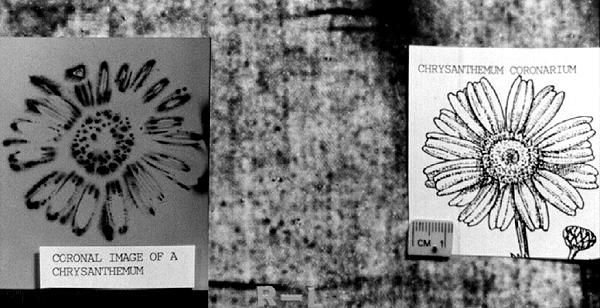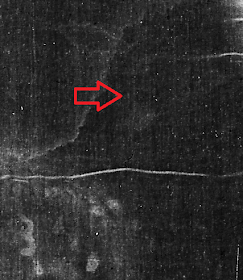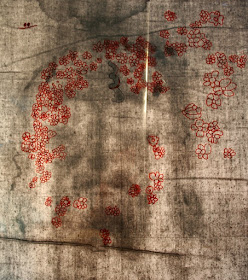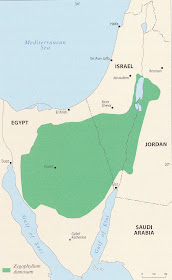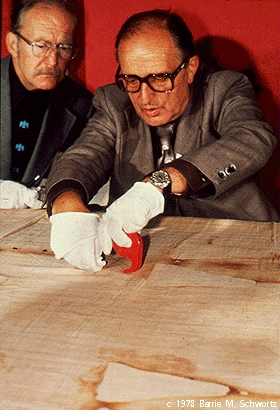This is part #11, "6 May 1988," of my series, "On this day 30 years ago in the radiocarbon dating of the Turin Shroud." For more information about this series, see part #1. I am still more than a month behind, but I will again catch up and then post each day in the radiocarbon dating of the Shroud as near to its 30th anniversary as possible. Emphases are mine unless otherwise indicated.
[Index #1] [Previous: 21Apr88 #10] [Next: 03Jul88 #12]
6 May 1988 At about 9:40am on Friday, 6 May 1988[2], Arizona radiocarbon dating laboratory began the first of its four runs of radiocarbon dating its Shroud samples[3], which was also the first
[Above (enlarge): Photograph of those present at the Arizona Accelerator Mass Spectrometry (AMS) radiocarbon dating laboratory at 9:50 am on 6 May 1988[4] when the AMS computer terminal [left] displayed a date of the Shroud, which when calibrated, was "1350 AD" (see below). The alleged hacker, Timothy W. Linick (1946-89) [see 22Feb16], is in a black shirt standing prominently in the foreground[5]. The 1989 Nature paper in footnote 9 acknowledged that Linick wrote the 1986 paper which described in detail the AMS radiocarbon system at Arizona[6]. So it is significant that Linick is standing in front of his Arizona laboratory leaders and colleagues in this historic group photograph of the very first dating of the Shroud, because this is evidence that Linick was in charge of the AMS computerised dating process at Arizona laboratory and those present were acknowledging that. See also my 22Nov16 where Prof. Harry Gove (1922-2009) must have realised by September 1988 that Linick was the leaker of Arizona's first "1350 AD" date to David Sox (1936-2016) [see 30Dec15], but Gove (and presumably the other laboratory leaders) covered it up! See also 25Mar18.]
radiocarbon dating of the Shroud[7]. At about 9:50 am the AMS computer terminal screen displayed the year of the Shroud sample, which when calibrated for past variations of atmospheric carbon dioxide[8] by Arizona laboratory co-founder Douglas J. Donahue was announced by him to be "1350 AD"[9]. According to the AMS computer screen, the Shroud was only about 640 years old[10], and so it could not have been Jesus' burial shroud[11].
Here is Sox's 1988 description of that first 6 May 1988 radiocarbon dating of the Shroud at Arizona [see 22Nov16]:
"At 9.50am what matters to the layman was available - the results of the measurements, the first carbon dating test on the Turin Shroud ... The night before the test Damon told Gove he would not be surprised to see the analysis yield a date around the fifth-century, because after that time the crucifixion was banned and a forger would not have known of the details depicted so accurately on the Shroud. Timothy Linick, a University of Arizona research scientist, said: `If we show the material to be medieval that would definitely mean that it is not authentic. If we date it back 2000 years, of course, that still leaves room for argument. It would be the right age - but is it the real thing?' Donahue's wife, who believed the Shroud was genuine, was going for 2000 years. So was Shirley Brignall [Gove's companion[12], who was a nuclear physicist[13] and an administrative assistant at Gove's Rochester University[14]. She and Gove had a bet. Gove said 1000 years although he hoped for twice that age. Whoever lost was to buy the other a pair of cowboy boots [see below]. The calculations were produced on the computer, and displayed on the screen. Even the dendrochronological correction was immediately available. All eyes were on the screen. The date would be when the flax used for the linen relic was harvested. Gove would be taking cowboy boots back to Rochester"[15].Note: ■ The Introduction by Sox in his book, "The Shroud Unmasked"
 [right] in which this appears is dated "August 1988"[16], so the book had already been written by Sox well before the 13 October official announ- cement of the 1260-1390 dating results [see future "13Oct88"[17].
[right] in which this appears is dated "August 1988"[16], so the book had already been written by Sox well before the 13 October official announ- cement of the 1260-1390 dating results [see future "13Oct88"[17].■ Paul Damon (1921-2005), with Donahue a co-founder of the Arizona laboratory, before the dating believed that the Shroud was "fifth-century [above], because after that time ... crucifixion was banned [by Emperor Constantine I in AD 337] and a forger would not have known of the details depicted so accurately on the Shroud"!
■ On the very same page of his book describing Arizona's first dating of the Shroud, Sox quoted "Timothy Linick [above], a University of Arizona research scientist"! Amazingly this seems not to  have been noticed by any Shroud pro-authenticists, even by Bruno Bonnet-Eymard (1938-), who noted [Left [18].] that Linick, an Arizona laboratory signatory to the 1989 Nature report, had "died at the age of forty-two on 4 June 1989, in very unclear circumstances." But Gove and Linick's Arizona laboratory leaders would have noticed it and demanded that Linick `please explain' why he had breached his confident- iality agreement [see below].
have been noticed by any Shroud pro-authenticists, even by Bruno Bonnet-Eymard (1938-), who noted [Left [18].] that Linick, an Arizona laboratory signatory to the 1989 Nature report, had "died at the age of forty-two on 4 June 1989, in very unclear circumstances." But Gove and Linick's Arizona laboratory leaders would have noticed it and demanded that Linick `please explain' why he had breached his confident- iality agreement [see below].
■ Linick was an extreme anti-authenticist who would not have accepted that the Shroud was authentic even it it "date[d] ... back 2000 years" [above].
■ "The calculations were produced on the computer, and displayed on the screen" [above]. So they could have been the result of a computer hacking (allegedly by Linick), which installed a program on the AMS computer that intercepted Shroud sample dates coming from the AMS system and substituted them with computer-generated dates, which when calibrated and averaged, clustered around a year (1325), which was only a few decades before the Shroud had first appeared in undisputed history at Lirey, France in c.1355.
■ Gove had not told Sox the Shroud's "1350 AD" first radiocarbon date [later confirmed by Sox - see future], but Gove had told Sox that the Shroud's age was closer to 1,000 than 2,000 years [above]. So Gove also had breached his confidentiality agreement! [see below].
Here is Gove's 1996 description of that first 6 May 1988 radiocarbon  dating of the Shroud at
dating of the Shroud at
[Right (enlarge): Prof. Harry E. Gove (1922-2009), co-developer of Accelerator Mass Spectrometry radiocarbon dating[19].]
Arizona [see 22Sep15]:
"The first sample run was OX1 [an oxalic acid standard]. Then followed one of the controls. Each run consisted of a 10 second measurement of the carbon-13 current and a 50 second measurement of the carbon-14 counts. This is repeated nine more times and an average carbon-14/carbon-13 ratio calculated. All this was under computer control and the calculations produced by the computer were displayed on a cathode ray screen. The age of the control sample could have been calculated on a small pocket calculator but was not-everyone was waiting for the next sample-the Shroud of Turin! At 9:50 am 6 May 1988, Arizona time, the first of the ten measurements appeared on the screen. We all waited breathlessly. The ratio was compared with the OX sample and the radiocarbon time scale calibration was applied by Doug Donahue. His face became instantly drawn and pale. At the end of that one minute we knew the age of the Turin Shroud! The next nine numbers confirmed the first. It had taken me eleven years to arrange for a measurement that took only ten minutes to accomplish! Based on these 10 one minute runs, with the calibration correction applied, the year the flax had been harvested that formed its linen threads was 1350 AD-the shroud was only 640 years old! It was certainly not Christ's burial cloth but dated from the time its historic record began ... I remember Donahue saying that he did not care what results the other two laboratories got, this was the shroud's age. Although he was clearly disappointed in the result, he was justifiably confident that his AMS laboratory had produced the answer to the shroud's age. Like Donahue, I also had wished for a 2000 year age. That result would have been so much more exciting. Of course, it would not have proved the shroud was Christ's burial cloth but it certainly would have upped the odds. As a scientist, I would have (and did) bet it was not that old ... When the results of all three labs were finally averaged, the date of the flax harvesting came out to be 1325 AD ±33 years. "That agreed with this initial Arizona result obtained in ten minutes using a piece of the shroud cloth measuring less than 1/4" x 1/4" inch." It was a triumph for carbon dating by AMS if not for those who passionately believed it was the burial cloth of Jesus Christ or for those of us who wished it might have been. I had a bet with Shirley on the shroud's age-she bet 2000 ±100 years old and I bet 1000 ±100 years. Whoever won bought the other a pair of cowboy boots. Although my guess was wrong, it was closer than Shirley's. She bought me the cowboy boots. The reader, by now, will have guessed that despite the agreement I had signed [see below], I told Shirley the result that had been obtained that day. She and I had been associated with this shroud adventure now for almost exactly eleven years-there was no way I could not tell her. I knew she would never violate my confidence and she never did. Her disappointment in the result was deeper and palpably more poignant than mine. She has told me that, even now, her heart still tells her it is Christ's shroud"[20].Note: ■ Gove also (with Sox above) states that "All this was under computer control" and "the calculations [were] produced by the computer" and it is those that "were displayed on" the AMS computer's terminal "screen" [above]! So they were not seeing the actual AMS system's date of the Shroud sample but what the AMS computer's program displayed it was! So again they could have been duped by a computer hacker (allegedly Linick), and in view of the overwhelming weight of the evidence that the Shroud is authentic, it is my theory that they were!
■ Gove's "At the end of that one minute we knew the age of the Turin Shroud" [above] is further evidence that they had been psychologically manipulated by the hacker's "1350 AD" date [see 22Feb16]. That is because, according to Gove, there was no need for Arizona, nor the other two laboratories, to do any further dating of the Shroud!
■ Gove's "the year the flax had been harvested that formed its linen threads was 1350 AD" [above] is a prime example of the "Law of the instrument," fallacy, popularly expressed in the saying, "To a man with a hammer, everything looks like a nail":
"The concept known as the law of the instrument, otherwise known as the law of the hammer, Maslow's hammer (or gavel), or the golden hammer, is a cognitive bias that involves an over-reliance on a familiar tool. As Abraham Maslow (1908-70) said in 1966, `I suppose it is tempting, if the only tool you have is a hammer, to treat everything as if it were a nail'"[21].That is, Gove and his fellow nuclear physicists arrogantly assumed that they did not need to know where the Shroud actually was in 1350: owned by Geoffroy I de Charny (c.1300–1356), one of the most noble, most ethical, knights in France, who in 1350 was a prisoner of war in England [see 10Feb18]! As Ian Wilson pointed out, "all involved with the carbon dating ... were physicists" and in their arrogance, born of ignorance, their "instruments had spoken, and that was it":
"But if there was one feature of the British Museum press conference [of 13 October 1988] that particularly astonished, and frankly annoyed me, it was Professor Hall's flat assertion, on the basis merely of the averaged `1260-1390 AD' dates quoted ... that the carbon dates have overwhelmingly proved the Shroud's fraudulence. Effectively we are supposed to believe that on the basis of one single branch of science, nuclear physics (and all involved with the carbon dating, including Gonella and Tite [sic], were physicists), every other scientific and historical contribution to the subject must now be tossed aside as totally worthless. As Hall admitted, it did not matter to him that there remained no clear explanation for how some hypothetical forger created the Shroud's image. The laboratories' instruments had spoken, and that was it"[22].■ By his, "It was certainly not Christ's burial cloth but dated from the time its historic record began" [above]. Gove here showed that he and the other radiocarbon scientists had been psychologically manipulated by the hacker's "1350 AD" date, in that their usual scientific objectivity had been suspended so that they never considered how unlikely it was that: 1. "the flax had been harvested" in "1350 AD"; 2. the linen fibres had been separated from the flax by retting which takes many months; 3. the linen fibres were then spun into thread; 4. the thread was woven into a linen sheet; and 5. Jesus' image was forged onto that linen sheet, all in five years, because "the time" the Shroud's historic record began" was only 5 years later in 1355!
■ Further evidence of the psychological effect of the hacker's "1350 AD" date on the scientists' critical faculties was Donahue saying that, "he did not care what results the other two laboratories got, this was the shroud's age" [above]. But that was after only the first one of the four Arizona dating runs, and the other two laboratories were yet to start their dating! See above on Gove's similar suspension of normal scientific scepticism.
■ "Like Donahue, I also had wished for a 2000 year age. That result would have been so much more exciting"[above]. Gove is here either lying or more likely self-deceived. His sustained campaign to ensure that STURP had no part in the radiocarbon dating of the Shroud, and his objection to some STURP members wearing Christian crosses revealed Gove to be a virulent (if not fanatical) anti-Christian - see 27Apr87, 15Jun87 and 10Oct87. See also next where Gove would have accepted the Shroud was authentic even if it did have a 2000 year age. Besides, if Gove really had wished for a 2000 year age of the Shroud why didn't he `put his money where his mouth was'?
■ "Of course, it would not have proved the shroud was Christ's burial cloth but it certainly would have upped the odds" [above]. Gove here reveals that he too, like Linick, was an extreme Shroud anti-authenticist [see above], in that he would not have accepted that the Shroud was authentic even if it had "a 2000 year age"! Clearly no amount of evidence for the Shroud's authenticity would have sufficed for Gove (or Linick). They were therefore invincibly ignorant regarding the Shroud's authenticity:
"There does remain, nonetheless, a cast of mind which seems peculiarly closed to evidence. When confronted with such a mind, one feels helpless, for no amount of evidence seems to be clinching. Frequently the facts are simply ignored or brushed aside as somehow deceptive, and the principles are reaffirmed in unshakable conviction. One seems confronted with what has been called `invincible ignorance'"[23].
■ "When the results of all three labs were finally averaged, the date of the flax harvesting came out to be 1325 AD ±33 years" [above]. Either Gove couldn't do simple arithmetic (the midpoint of 1260-1390, which he agreed was the range of the Shroud's radiocarbon dating[24], is 1325 AD ±65 years)! Or did Gove deliberately falsify the range, to avoid the problem that 1325 + 65 = 1390 which is 35 years after Shroud first appeared in undisputed history in 1355?:
"Omitting to address the problems of the non-representative nature of the mediaeval mean, or the value of the entire statistical analysis, Gove instead somewhat characteristically resolved everything by simply falsifying the mean. Pretending, without showing his workings, to determine the mean with an extreme precision (1325 years ± 33 years), he distanced himself from all the objections made and others which went unsaid, not least by ignoring even mention of any statistical calculations. Having thereby disposed of the spread among the dates, he behaved as if issues such as the control samples and the question of their origin should similarly thenceforth be beyond dispute"[25].■ "That agreed with this initial Arizona result obtained in ten minutes

[Left (enlarge): Extract from Table 1 in the 1989 Nature paper, showing the dates of each run at each laboratory of Sample 1, the Shroud[26]. The dates are years before 1950[27]. Thus the corrected mean of Arizona's first date was actually 1950-591=1359. As can be seen there was a very wide spread of the mean dates within each laboratory and across the three laboratories. Arizona's mean maximum was 701 and its minimum was 591, a spread of 110 years! Oxford's mean maximum was 795 and its minimum 730, a spread of 65 years. Zurich's maximum was 733 and its minimum 635, a spread of 98 years. For all three laboratories the maximum mean was 795 (Oxford) and the minimum was 591 (Arizona's first date), a spread of 204 years!]
using a piece of the shroud cloth measuring less than 1/4" x 1/4" inch." [above]. Gove doesn't consider how amazing it is, that the very first dating at Arizona, "1350 AD," agreed to within 25 years of the midpoint, 1325, of the average of all the other datings! Especially considering the very wide spread of all those datings: 204 years! (see above), and Arizona's 110 years. In fact the mean of Arizona's first date, 591±30 is not a typical one: it is the lowest of all the means. And because lowest is most recent, it is the upper limit of the dating's calendar years. It was pointed out in 1994 by a Victor de Vincenzo in the USA that if it was not for Oxford's inconsistently older dates, the dating would have overlapped even more the year 1355, when the Shroud first appeared in undisputed history:
"Father Peter Rinaldi ... was also disturbed by the inconsistencies of the 1988 results as published in Nature in 1989. The Arizona and Switzerland lab dates gave a later age (late 14th century) than the final published results. The Oxford lab dates came in late and conveniently low enough to skew the average of the three labs to an early 14th century date instead of a late 14th century date. Had the Oxford lab been consistent with the other two labs, the late 14th century results would clearly have made the whole procedure erroneous since we know that the Holy Shroud had to have been in existence in the early 14th Century since it was exhibited in 1355 in France"[28].So presumably it was part of the design of the hacker's (allegedly Linick's) algorithm, that the Shroud's date could not go above 1350. See my 22Febr16 where I proposed that 1350 "was a `hard-wired' straight substitution ... for the actual Shroud date." See future "16Feb89" where this much wider than expected variability of the laboratories' results for the Shroud sample, which was even admitted in the 1989 Nature paper's Table 2 summary of Table 1, is inexplicable [13Jun14, 26Oct14, 11Feb15, 18Nov15 & 24Oct16] and indeed impossible [26Oct14, 03Jun15, 27Aug15 & 26May18] if the dates of the Shroud sample at each laboratory were real. But it is explicable if those dates were computer-generated by a hacker's (allegedly Linick's) program!
■ "It was a triumph for carbon dating by AMS if not for those who passionately believed it was the burial cloth of Jesus Christ ..." [above]. As Ian Wilson observed:
"... it would seem more and more evident that in the laboratories' eyes the Shroud was a hotly prized test for the AMS carbon-dating method, rather than the AMS method a cool, wholly impartial test for the Shroud"[29].As for Gove's "... not for those who passionately believed it was the burial cloth of Jesus Christ," Gove died in 2009, so maybe he now knows (too late) how wrong he was? [2Pet 2:9].
■ "I had a bet with Shirley on the shroud's age-she bet 2000 ±100 years old and I bet 1000 ±100 years. Whoever won bought the other a pair of cowboy boots. Although my guess was wrong, it was closer than Shirley's. She bought me the cowboy boots."[above]. See also above where Gove had breached his confidentiality agreement (see below) by telling Sox that Arizona's first date of the Shroud was closer to 1,000 than 2,000 years ago. That meant that Gove twice breached his confidentiality agreement by first telling it to his companion Shirley Brignall. Wilson, commenting on this part of Sox's book, noted:
"We are yet again reminded of the soldiers casting lots for Jesus's clothing [Mt 27:35; Mk 15:24; Lk 23:34; Jn 19:24] at the foot of the cross..."[30].■ "The reader, by now, will have guessed that despite the agreement I had signed [see below], I told Shirley the result that had been obtained that day. She and I had been associated with this shroud adventure now for almost exactly eleven years-there was no way I could not tell her. I knew she would never violate my confidence and she never did." [above]. Sox had already `outed' Gove on this ~8 years before [above]. If "there was no way" that Gove "could not tell" Brignall Arizona's first date of the Shroud (and presumably Gove did tell her it was "1350") then he should not have signed the confidentiality agreement. Gove is trying to justify his dishonesty by claiming that Brignall "would never" and "never did" violate his confidence (how would Gove know that?) is besides the point. Archeologist William Meacham pointed out:
"In sum, he [Gove] gave his word to his colleagues, as a scientist and a gentleman, and he broke it the very same day"[31]!Before the dating Gove, who had been invited by Donahue to be present as an observer [see 25Mar18] arrived with Shirley Brignall in Tucson, Arizona on the afternoon of the day before, 5 May 1988[32]. Gove phoned Donahue who suggested he (not Brignall) be at the laboratory at 8am the next morning[33]. That evening Damon called at the motel that Gove and Brignall were staying and updated them on the sample removal, its cleaning and that Arizona had divided the total area of its Shroud samples (see 26May18 where due to a mistake in cutting, Arizona was given its sample in two pieces) "about 2 square centimetres (0.3 square inches) ... into four pieces each about 0.5 square centimetres or 1/4" x 1/4" in area" and stored them each in different places[34]. After the dating, Gove and Brignall were shown
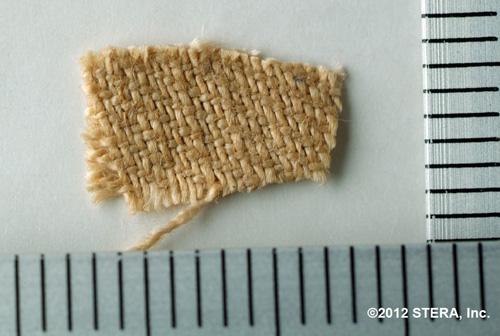
[Above (enlarge): Photomicrograph of one of Arizona laboratory's remaining undated Shroud sub-samples, taken by former STURP photographer Barrie Schwortz in 2012[35]. As can be seen, it has no obvious contamination or foreign fibres. This looks like it may be a part of the sample that Gove saw, from a black-and-white photograph of it in Gove's book[36]. Of that sample Gove pointed out:
"If the shroud were actually first century and modern contamination produced the 14th century result this sample would have to be two thirds shroud and one third contamination"[37].]one of Arizona's four subdivided pieces of its samples, which had been cleaned[38]. Of that sample he saw (which may have been a larger piece from which the above sub-sample was cut) Gove noted:
"After cleaning the shroud linen, it was still slightly yellowish in colour. The shroud sample could be readily identified. This was actually an advantage because it dispelled the concern that 14th century linen had been somehow substituted for shroud samples"[39].However, this is further evidence for my hacking theory. See my 23Jul15 that, "Conventional explanations of the discrepancy [i.e. carbon contamination, bioplastic coating, invisible repairs] all fail."
At 8 am of the next morning, the day of Arizona's first dating, 6 May 1988, Gove arrived at the radiocarbon dating laboratory alone[40]. Gove had previously asked Donahue if Brignall could also attend the dating but that was refused[41]. Gove would be the only one present at Arizona's first dating of the Shroud who was not a member of the Arizona AMS group[42]. Donahue then asked Gove to sign a confidentiality agreement as follows:
"We the undersigned, understand that radiocarbon age results for the Shroud of Turin obtained from the University of Arizona AMS facility are confidential. We agree not to communicate the results to anyone-spouse, children, friends, press, etc., until that time when results are generally available to the public"[43].Note that the confidentiality agreement prohibited communicating the Shroud dating results even to "spouses"! So, as mentioned previously, if "there was no way" that Gove "could not tell" Brignall, who was effectively Gove's spouse, what Arizona's first date of the Shroud was, then Gove, if he was a man of honour, should not have signed the agreement as he did (below). Let alone that Gove also told Sox before August 1988 when Sox's book was completed, that the result of Arizona's first first dating of the Shroud was that its age was closer to 1,000 than 2,000 years (see above)!
"It had been signed by D J Donahue, Brad Gore, L J Toolin, P E Damon, Timothy Jull and Art Hatheway, all connected with the Arizona AMS facility, before I signed. My signature was followed by T W Linick and P J Sercel, also from the Arizona facility"[44].So Gove would have had no moral authority to criticise Linick for not honouring his signing of the confidentiality agreement when Gove discovered by September 1988 [see above] that Linick had told Sox that the result of Arizona's first Shroud dating was "1350" [see 30Dec15], when Gove himself had told Sox that the result was that the Shroud's age was closer to 1,000 than 2,000 years!
Continued in the next part #12 of this series.
Notes
1. This post is copyright. I grant permission to quote from any part of it (but not the whole post), provided it includes a reference citing my name, its subject heading, its date, and a hyperlink back to this page. [return]
2. Gove, H.E., 1996, "Relic, Icon or Hoax?: Carbon Dating the Turin Shroud," Institute of Physics Publishing: Bristol UK, p.264.[return]
3. Damon, P.E., et al., 1989, "Radiocarbon Dating of the Shroud of Turin," Nature, Vol. 337, 16 February, pp.611-615, 611. [return].
4. Gove, 1996, p.176H. [return]
5. Jull, A.J.T. & Suess, H.E., 1989, "Timothy W. Linick," Radiocarbon, Vol 31, No 2. [return]
6. Linick, T.W., et al., 1986, "Operation of the NSF-Arizona accelerator facility for radioisotope analysis and results from selected collaborative research projects," Radiocarbon, Vol. 28, No. 2a, pp.522-533. [return]
7. Gove, 1996, p.324; Meacham, W., 2005, "The Rape of the Turin Shroud: How Christianity's Most Precious Relic was Wrongly Condemned and Violated," Lulu Press: Morrisville NC, p.92. [return]
8. Sox, H.D., 1988, "The Shroud Unmasked: Uncovering the Greatest Forgery of All Time," The Canterbury Press: Scoresby, VIC Australia, p.146. [return]
9. Gove, 1996, p.264; Wilson, I., 1998, "The Blood and the Shroud: New Evidence that the World's Most Sacred Relic is Real," Simon & Schuster: New York NY, p.310; Wilson, I. & Schwortz, B., 2000, "The Turin Shroud: The Illustrated Evidence," Michael O'Mara Books: London, p.9; Wilson, I., 2010, "The Shroud: The 2000-Year-Old Mystery Solved," Bantam Press: London, p.308. [return]
10. Gove, 1996, p.264; Garza-Valdes, L.A., 1998, "The DNA of God?," Hodder & Stoughton: London, pp.163, 180. [return]
11. Gove, 1996, p.264. [return]
12. Antonacci, M., 2000, "Resurrection of the Shroud: New Scientific, Medical, and Archeological Evidence," M. Evans & Co: New York NY, p.183. [return]
13. Wilson, I., 1991, "Holy Faces, Secret Places: The Quest for Jesus' True Likeness," Doubleday: London, p.8. [return]
14. Gove, 1996, p.312. [return]
15. Sox, 1988, p.146. [return]
16. Sox, 1988, p.6. [return]
17. Wilson. I., 1988, "Recent Publications," BSTS Newsletter," No. 20, October, pp.18-19; Crispino, D., 1990, "Recently Published," Shroud Spectrum International, Nos. 35/36, June/September, pp.29-37, 30; Paci, S.M., 1990. "The Case is Not Closed!," Shroud News, No 60, August, pp.4-11, 8; Petrosillo, O. & Marinelli, E., 1996, "The Enigma of the Shroud: A Challenge to Science," Scerri, L.J., transl., Publishers Enterprises Group: Malta, pp.11, 109; Guerrera, V., 2001, "The Shroud of Turin: A Case for Authenticity," TAN: Rockford IL, p.134. [return]
18. Bonnet-Eymard, B., 2000, "The Holy Shroud is as Old as the Risen Jesus, IV. Caution! Danger!, The Catholic Counter-Reformation in the XXth Century, No 330, Online edition, May. [return]
19. Extract from, "Dr. Harry Gove Co-developer, Accelerator Mass Spectrometry," El carbono 14, por Manuel Carreira, Sabana Santa, 2013. [return]
20. Gove, 1996, pp.264-265. [return]
21. "Law of the instrument," Wikipedia, 22 April 2018. [return]
22. Wilson, I., 1988, "Editorial and The Carbon Dating Results: Is This Now the End?," BSTS Newsletter, No. 20, October, pp.2-10, 4. [return]
23. Fearnside, W.W. & Holther, W.B., 1959, "Fallacy the Counterfeit of Argument," Prentice-Hall: Englewood Cliffs NJ, 25th printing, p.113. [return]
24. Gove, 1996, p.301; Gove, H.E., 1999, "From Hiroshima to the Iceman: The Development and Applications of Accelerator Mass Spectrometry," Institute of Physics Publishing: Bristol UK, p.161. [return]
25. Van Oosterwyck-Gastuche, M.C., 1991, "The dating of the Shroud to the Middle Ages: Episodes in a game of technological bluff," BSTS Newsletter, 29, September, pp.7-14, 12. [return]
26. Damon, et al., 1989, p.612. [return]
27. Damon, et al., 1989, p.611. [return]
28. de Vincenzo, V., 1994, "12 reasons why I cannot accept the carbon-14 test results on the Holy Shroud of Turin," Shroud News, No 82, April, pp.3-13, 11 (typos corrected). [return]
29. Wilson, I., 1989, "Recent Publications: Archaeometry," BSTS Newsletter, No. 23, September, pp.14-19, 19. [return]
30. Wilson. I., 1988, "Recent Publications," BSTS Newsletter," No. 20, October, pp.18-19, 19. [return]
31. Meacham, 2005, p.93. [return]
32. Gove, 1996, p.259. [return]
33. Ibid. [return]
34. Gove, 1996, pp.259-260. [return]
35. "New Photographs Of Arizona Radiocarbon Dating Laboratory Samples," Shroud.com, November 21, 2012. [return]
36. Gove, 1996, p.265. [return]
37. Ibid. [return]
38. Gove, 1996, pp.259-260. [return]
39. Gove, 1996, p.260. [return]
40. Gove, 1996, p.262. [return]
41. Ibid. [return]
42. Ibid. [return]
43. Ibid. [return]
44. Ibid. [return]
Posted 23 June 2018. Updated 2 October 2025.



